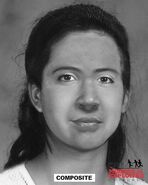Sandra "Sandy" Renee Morden was a teenager whose partial skeleton was found in Washington in 1980. It is believed that she died in the late 1970s. She was identified in October 2019 via forensic genealogy and the help of Parabon NanoLabs.
Background
Sandy and her parents, Andrew "Andy" Bain Morden and Kathryn Irene "Irene" Morden, moved to Portland, Oregon from the San Francisco Bay area. Andy, who was a Marine Corps veteran of the Korean War era, worked in the maritime trades on tugboats providing service to pulp, paper, and logging interests on the Willamette and Columbia Rivers.
Andy and Irene were divorced in the early 1970s, with Andy assuming custody of Sandy. Following the divorce, Irene lived separately at various locations in Portland and in the Bay area. Andy and Sandy lived in Portland and Vancouver.
Sandy attended Binnesmead Middle School (now Harrison Park Middle School) on SE 87th Avenue in Portland in 1974 and 1975. She attended Gaiser Middle School on NE 99th Street in Vancouver in 1975 and 1976. She attended Wilson High School on SW Vermont Street in Portland in 1976 and 1977.
Irene Morden passed away in San Francisco in 1988. Andy Morden retired to Ilwaco, Washington, where he died in 1999.
Case
On the morning of February 24th, 1980 Jack D. Bannister and his son Jack P. Bannister of Vancouver, WA were panning for gold along the Fly Creek near NF-54 at the split with Canyon Creek. While doing this, the two stumbled among the remains of a young woman’s skeleton, minus her torso and hands. The father alerted Clark County Sheriff officials at the Chelatchie Prairie General Store, where investigators were led to the remains. Photographs were taken of the scene and the partial skeletal remains of the woman were taken to the Clark County Medical Examiner’s Office, where then-coroner Arch Hamilton studied them.
The initial findings were that the remains were that of a young person, unsure whether male or female and that a cause of death was undetermined. A few days later, updates were made to include that the remains were that of a female between 13-18 years of age with a likely range of 15-16 when she died.
Police combed the area of the discovery for two weeks, including using specialists with the Portland Police Bureau and the King County Sheriff's Office K-9 Unit out of Seattle. These efforts did not yield any new results.
Periodic postings of the case made their way to the Oregonian and the Clark County Columbian. An initial composite of the Jane Doe was made shortly after the discovery by FBI agents at the Portland Office, yet this composite has since been lost. In 2004, a reinvigorated effort to identify this woman began and the National Center for Missing and Exploited Children became involved with this effort. In 2005, NCMEC released a new composite of the Jane Doe using new technology that NCMEC created to help identify young deceased individuals.
She was initially believed to have Native American or Hispanic traits based on the formation of the skull. She had well-developed neck muscles, indicating that in her past, she had either played sports or was an active laborer. DNA phenotyping by the Parabon Nanolabs disproved the previous assumption she belonged to racial minorities. The results indicated she was of European descent. A more recent effort began to identify the Jane Doe in 2016, with Dr. Nikki Costa of the Clark County Medical Examiner's Office taking the lead. A new NCMEC reconstruction was commissioned using new software analyzing a 3D rendering of the skull; producing a nearly lifelike photograph of the girl.
She is not considered to be a victim of serial killer Ted Bundy, according to Clark County (WA) Sheriff's Office.
In 2018, a volunteer research effort dubbed "The Fly Creek Jane Doe Task Force" was founded. The organization later announced there would be a $500 reward is being offered for information that would lead to the successful identification of the Jane Doe.
Identification
On October 29, 2019, the Clark County Sheriffs Office announced that The Fly Creek Jane Doe was identified as Sandra "Sandy" Morden and that they are attempting to speak with any acquaintances or friends of Morden's and the timeline of her disappearance. She had last been heard from in 1977. Her identification was aided by Parabon Nanolabs' Snapshot program and did not rely on public genealogy websites such as 23andMe or Ancestry.
The victim was identified prior to the release of their own artistic rendering, which incorporated phenotype results. They approximated coloration of Morden's eyes, hair, and complexion, which were previously undetermined following the effects of decomposition.
Additional information is forthcoming.











